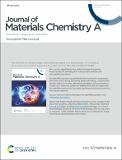Files in this item
A B-site doped perovskite ferrate for efficient anode of a solid oxide fuel cell with in situ metal exsolution
Item metadata
| dc.contributor.author | Ni, Chengsheng | |
| dc.contributor.author | Zeng, Qimiao | |
| dc.contributor.author | He, Debo | |
| dc.contributor.author | Peng, Luo | |
| dc.contributor.author | Xie, Deti | |
| dc.contributor.author | Irvine, John T.S. | |
| dc.contributor.author | Duan, Shukai | |
| dc.contributor.author | Ni, Jiupai | |
| dc.date.accessioned | 2020-10-29T00:38:45Z | |
| dc.date.available | 2020-10-29T00:38:45Z | |
| dc.date.issued | 2019-12-21 | |
| dc.identifier | 262527192 | |
| dc.identifier | 6d6292e3-9135-4fa3-9d46-753d507564d0 | |
| dc.identifier | 85075985989 | |
| dc.identifier | 000501811800021 | |
| dc.identifier.citation | Ni , C , Zeng , Q , He , D , Peng , L , Xie , D , Irvine , J T S , Duan , S & Ni , J 2019 , ' A B-site doped perovskite ferrate for efficient anode of a solid oxide fuel cell with in situ metal exsolution ' , Journal of Materials Chemistry A , vol. 7 , no. 47 , pp. 26944-26953 . https://doi.org/10.1039/C9TA09916F | en |
| dc.identifier.issn | 2050-7488 | |
| dc.identifier.other | Bibtex: C9TA09916F | |
| dc.identifier.other | ORCID: /0000-0002-8394-3359/work/68280842 | |
| dc.identifier.uri | https://hdl.handle.net/10023/20852 | |
| dc.description | This work is supported by the NSFC (grant No. 51702264; 41371275) and National Key Research and Development Program of China (grant No. 2018FYD0200701) and research funding for central universities (XDJK2019D04). | en |
| dc.description.abstract | Compared to Ni(O) cermet, an oxide anode is much better for a solid oxide fuel cell at suppresses coking and carbon deposition with carbonaceous fuels. Furthermore, a small amount of metal nanoparticles can enhance the electrochemical performance of the oxide anode while maintaining compatibility with the carbonaceous fuel when anchored on the oxide surface. In this study, ferrate-based perovskites (La0.95Fe0.80Ni0.05Ti0.15O3, LFNT) with Ni0 particles exsolution are investigated via B-site doping to increase the stability at 800 oC in H2 atmosphere and electrocatalytic capability for fuel oxidation. Surprisingly, the B-site doped LaFeO3 (La0.95Fe0.8Mg0.2O3, LFM) showed a high oxide-ion conductivity of 10 mS cm-1 with limited electronic conduction and further doping of Ti4+ or Ni2+ could increase the electronic conductivity to 30 Scm-1 and 100 Scm-1 at 800 oC for the reduced La0.95Fe0.8Mg0.05TiO3 (LFMT) and LFNT, respectively. The cell with LFNT anode on a La0.9Sr0.1Ga0.8Mg0.2O2.85 electrolyte shows a polarisation resistance of 0.32 Ωcm2 at 800 oC and a high power density of 600 mWcm-2 can be obtained when ceria is added via infiltration as a co-catalyst. | |
| dc.format.extent | 10 | |
| dc.format.extent | 2984718 | |
| dc.language.iso | eng | |
| dc.relation.ispartof | Journal of Materials Chemistry A | en |
| dc.subject | QD Chemistry | en |
| dc.subject | Chemistry(all) | en |
| dc.subject | Renewable Energy, Sustainability and the Environment | en |
| dc.subject | Materials Science(all) | en |
| dc.subject | NDAS | en |
| dc.subject | SDG 7 - Affordable and Clean Energy | en |
| dc.subject.lcc | QD | en |
| dc.title | A B-site doped perovskite ferrate for efficient anode of a solid oxide fuel cell with in situ metal exsolution | en |
| dc.type | Journal article | en |
| dc.contributor.institution | University of St Andrews. School of Chemistry | en |
| dc.contributor.institution | University of St Andrews. Centre for Designer Quantum Materials | en |
| dc.contributor.institution | University of St Andrews. EaSTCHEM | en |
| dc.identifier.doi | https://doi.org/10.1039/C9TA09916F | |
| dc.description.status | Peer reviewed | en |
| dc.date.embargoedUntil | 2020-10-29 |
This item appears in the following Collection(s)
Items in the St Andrews Research Repository are protected by copyright, with all rights reserved, unless otherwise indicated.

